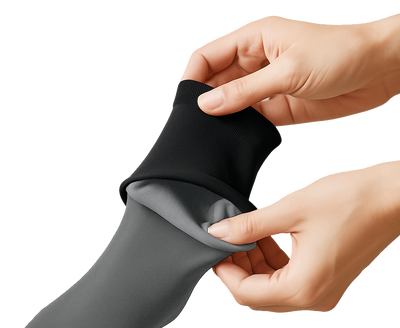Benefits of Compression socks on Lymphedema

What is lymphedema?
Lymphatic obstruction or lymphedema is caused by damage or blockage of lymph nodes resulting in excess fluid retention in tissues and swelling.
Lymphedema develops when there is damage to the lymph and lymphatic system. The fluid then collects in the tissue causing swelling in some parts of the body. Those parts are most commonly legs or arms.
What causes lymphedema in legs?
A blockage in the lymphatic system causes lymphedema in the legs. Damaged lymph nodes commonly cause this blockage as a result of cancer or radiation treatment.
Lymphedema develops when the lymph fluid doesn’t drain well, so it builds up in the tissue causing swelling in the legs. The swelling is uncomfortable, restricts flexibility and motion.

Within time, lymphedema can develop fibrosis (skin-thickening) or other skin diseases.
Now that we know what causes lymphedema in the legs, let’s talk about who is at risk of developing it.
Is lymphedema hereditary?
There are two types of lymphedema – primary and secondary.
Primary lymphedema
Primary lymphedema is a genetic or developmental mutation that causes impairment of lymph nodes. Even though there is no real evidence of primary lymphedema being a hereditary disease, it tends to run in families, classifying it as genetic.
There are 3 types of primary lymphedema according to age.
- Congenital lymphedema (Lymphedema I)means that it is onset on birth. This type is also called Noone-Milroy syndrome or Milroy disease and can be seen in newborns when their extremities tend to swell.
- Hereditary lymphedema II (Lymphedema Praecox Meige) is commonly developed at a young age, between puberty and adulthood (35 years).
- Hereditary lymphedema III - appears in adults older than 35.
Secondary lymphedema
Secondary lymphedema is caused by damaged, removed or injured lymph vessels and lymphatic systems.
Reasons can be numerous, but the most common reasons are cancer, severe and invasive operations, cancer treatment and radiation, obesity, infections, venous diseases, or trauma.
What are the stages of lymphedema?
So, now we have some insight on how the disease develops, but what are the stages of lymphedema?
If the disease is not treated constantly and with care, there is a chance of fast progression. The speed of which depends on patients, and some progress faster than others.

There are 4 stages of lymphedema:
Stage 1: Latent lymphedema
Stage one doesn’t usually show any signs or symptoms, even though the lymphatic system is damaged. In postoperative patients or cancer survivors, it can take years for the disease to develop and to show.
Stage 2: Mild lymphedema
Mild lymphedema suggests early retention of the excess fluid. In this stage, the swelling will not be severe, but there may be some pitting. Pitting is when an indentation, due to pressure, stays in the skin longer than expected. In this stage, you can reduce swelling by elevating your feet or by wearing compression socks or sleeves.
Stage 3: Moderate lymphedema
In this stage, lymphedema becomes permanent, meaning it cannot be reduced or prevented with elevating. Applying pressure to the skin no longer leaves a print, but the skin thickens and develops fibrosis.
Stage 4: Severe lymphedema (elephantiasis)
The skin thickens, and it starts to develop severe limb deformity called elephantiasis. The skin suffers many problems like hyperpigmentation, wart growth, and collecting fat.
Is lymphedema painful?
In severe cases such as stage 4, lymphedema can cause pain and movement restriction. In the early stages, lymphedema is painless.
How to treat lymphedema?
There is no cure for lymphedema, but the early symptoms can be reduced, and the disease can be prevented in some cases.

Treating lymphedema includes exercising and movement, massages, bandage, pneumatic compression, elevating the limbs, compression garments (compression socks, compression gloves) and surgical treatments.
Preventing lymphedema also includes exercising, keeping an eye on the diet, maintaining body hygiene, wearing the right clothes and accessories (gloves in the garden, compression socks in the gym), etc. Wearing compression garment in the early stages, but also as a precaution can help not only lymphedema but also venous insufficiency, blood circulation problems, and swelling.
Does losing weight help lymphedema?
Some studies have shown that losing weight can reduce lymphedema. Obesity can significantly increase your chances of getting this disease, as more fat requires more blood vessels.
Benefits of compression socks for lymphedema
The benefits of compression socks for lymphedema are numerous, as the compression material helps with reducing swelling, ache, and the feeling of heaviness.
Lymphedema garments include all the compression garments for your extremities, such as compression gloves, arm sleeves, or compression stocking and socks.
Skineez Hydrating medical-grade compression socks are made to help blood circulation have natural and healthy blood flow and to support natural lymph fluid drainage. These hydrating lymphedema socks can be used in the latent to moderate stages of the disease and have an impact on reducing problems due to swelling. They are moisturizing and infused with nurturing ingredients making them healthy for your skin. Skineez® socks are woven differently, so the material is ultra-soft, supple, and easier to put on than other compression brands.
Lymphedema socks can have different levels of compression, going from mild to strong. Stronger compression should be discussed with a doctor. When you are searching for the perfect lymphedema stocking, you should consider the level of ache or swelling, and you should always consult a medical expert.
Pressure stocking for lymphedema doesn’t help when you develop severe elephantiasis.
How do you find the right compression socks for lymphedema?
The difference between compression lymphedema socks is in their level of compression. With consulting your doctor, you would have a better idea of what you need.
Compression socks for lymphedema can range from mild, moderate to strong compression, and what you need depends on the level and stage of lymphedema you have.
The most common garments are compression stockings for lymphedema, although Skineez® also caries Compression Sleeves.
How long to wear compression socks for lymphedema?
You should wear lymphedema compression garments every day. Put them on the first thing in the morning and wear them throughout the whole day. You should take off your socks before you go to bed and wash them for the next day.
By washing them daily, you are preventing infections caused by bacteria or fungi. You can take them off when you are elevating your legs, but when walking or sitting with your legs down, you should not take them off.
Skineez Hydrating compression socks will last 4 months with proper care. Every 10th time you wash your clothes, you should use our Replenishing spray to reinfuse them with hydrating skin-nurturing ingredients. This way they will be as good as new, keeping your skin fresh and making you comfortable for a long time.



